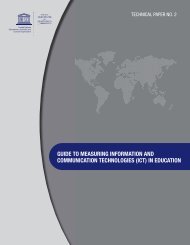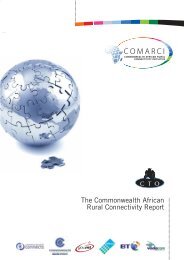ict in agriculture - Commonwealth Telecommunications Organisation
ict in agriculture - Commonwealth Telecommunications Organisation
ict in agriculture - Commonwealth Telecommunications Organisation
Create successful ePaper yourself
Turn your PDF publications into a flip-book with our unique Google optimized e-Paper software.
SECTION 1 — OVERVIEW OF ICT IN AGRICULTURE: OPPORTUNITIES, ACCESS, AND CROSS-CUTTING THEMES 3<br />
Module 1: INTRODUCTION: ICT IN AGRICULTURAL<br />
DEVELOPMENT<br />
KERRY MCNAMARA (American University), CORY BELDEN (World Bank), TIM KELLY (Infodev, World<br />
Bank Group), EIJA PEHU (World Bank), and KEVIN DONOVAN (Infodev, World Bank Group)<br />
INFORMATION AND COMMUNICATION<br />
TECHNOLOGY: FINDING A PLACE IN THE<br />
AGRICULTURE SECTOR<br />
Information and communication have always mattered <strong>in</strong><br />
<strong>agriculture</strong>. Ever s<strong>in</strong>ce people have grown crops, raised livestock,<br />
and caught fish, they have sought <strong>in</strong>formation from<br />
one another. What is the most effective plant<strong>in</strong>g strategy on<br />
steep slopes? Where can I buy the improved seed or feed this<br />
year? How can I acquire a land title? Who is pay<strong>in</strong>g the highest<br />
price at the market? How can I participate <strong>in</strong> the government’s<br />
credit program? Producers rarely f<strong>in</strong>d it easy to obta<strong>in</strong><br />
answers to such questions, even if similar ones arise season<br />
after season. Farmers <strong>in</strong> a village may have planted the<br />
“same” crop for centuries, but over time, weather patterns<br />
and soil conditions change and epidemics of pests and diseases<br />
come and go. Updated <strong>in</strong>formation allows the farmers<br />
to cope with and even benefit from these changes. Provid<strong>in</strong>g<br />
such knowledge can be challeng<strong>in</strong>g, however, because the<br />
highly localized nature of <strong>agriculture</strong> means that <strong>in</strong>formation<br />
must be tailored specifically to dist<strong>in</strong>ct conditions.<br />
Agriculture is fac<strong>in</strong>g new and severe challenges <strong>in</strong> its own<br />
right (see box 1.1). With ris<strong>in</strong>g food prices that have pushed<br />
over 40 million people <strong>in</strong>to poverty s<strong>in</strong>ce 2010, more effective<br />
<strong>in</strong>terventions are essential <strong>in</strong> <strong>agriculture</strong> (World Bank 2011).<br />
The grow<strong>in</strong>g global population, expected to hit 9 billion by<br />
2050, has heightened the demand for food and placed pressure<br />
on already-fragile resources. Feed<strong>in</strong>g that population will<br />
require a 70 percent <strong>in</strong>crease <strong>in</strong> food production (FAO 2009).<br />
Fill<strong>in</strong>g the stomachs of the grow<strong>in</strong>g population is only one reason<br />
<strong>agriculture</strong> is critical to global stability and development.<br />
It is also critical because one of the most effective ways of<br />
reduc<strong>in</strong>g poverty is to <strong>in</strong>vest <strong>in</strong> and make improvements <strong>in</strong><br />
the agricultural sector. Even after years of <strong>in</strong>dustrialization<br />
and growth <strong>in</strong> services, <strong>agriculture</strong> still accounts for one-third<br />
of the gross domestic products (GDP) and three-quarters<br />
of employment <strong>in</strong> sub-Saharan Africa. Over 40 percent of<br />
the labor force <strong>in</strong> countries with per capita <strong>in</strong>comes <strong>in</strong> the<br />
US$ 400 to 1,800 range works <strong>in</strong> <strong>agriculture</strong> (World Bank<br />
2008). Because <strong>agriculture</strong> accounts for the vast majority of<br />
the poor’s livelihood activities, it is also the sector that holds<br />
ECONOMIC AND SECTOR WORK<br />
the most promise for pro-poor economic growth. In fact, <strong>agriculture</strong><br />
is around four times more effective at rais<strong>in</strong>g <strong>in</strong>comes<br />
among the poor than other sectors (World Bank 2008). No<br />
less important, improved <strong>agriculture</strong> also has a direct impact<br />
on hunger and malnutrition, decreas<strong>in</strong>g the occurrences of<br />
fam<strong>in</strong>e, child stunt<strong>in</strong>g, and maternal <strong>in</strong>firmity.<br />
Given the challenges, the arrival of <strong>in</strong>formation communication<br />
technology (ICT) is well timed. The benefits of the<br />
green revolution greatly improved agricultural productivity.<br />
However, there is a demonstrable need for a new revolution<br />
that will br<strong>in</strong>g lower prices for consumers (through reduced<br />
waste and more-efficient supply cha<strong>in</strong> management), contribute<br />
to “smart” <strong>agriculture</strong>, and <strong>in</strong>centivize farmers (for<br />
example, through higher <strong>in</strong>come) to <strong>in</strong>crease their production.<br />
Public and private sector actors have long been on the<br />
search for effective solutions to address both the long- and<br />
short-term challenges <strong>in</strong> <strong>agriculture</strong>, <strong>in</strong>clud<strong>in</strong>g how to answer<br />
the abundant <strong>in</strong>formation needs of farmers. ICT is one of<br />
these solutions, and has recently unleashed <strong>in</strong>credible potential<br />
to improve <strong>agriculture</strong> <strong>in</strong> develop<strong>in</strong>g countries specifically.<br />
Technology has taken an enormous leap beyond the costly,<br />
bulky, energy-consum<strong>in</strong>g equipment once available to the<br />
very few to store and analyze agricultural and scientific data.<br />
With the boom<strong>in</strong>g mobile, wireless, and Internet <strong>in</strong>dustries,<br />
ICT has found a foothold even <strong>in</strong> poor smallholder farms<br />
and <strong>in</strong> their activities. The ability of ICTs to br<strong>in</strong>g refreshed<br />
momentum to <strong>agriculture</strong> appears even more compell<strong>in</strong>g <strong>in</strong><br />
light of ris<strong>in</strong>g <strong>in</strong>vestments <strong>in</strong> agricultural research, the private<br />
sector’s strong <strong>in</strong>terest <strong>in</strong> the development and spread<br />
of ICTs, and the upsurge of organizations committed to the<br />
agricultural development agenda.<br />
But what exactly are ICTs? And can they really be useful and<br />
cost-effective for poor farmers with restr<strong>ict</strong>ed access to capital,<br />
electricity, and <strong>in</strong>frastructure? First, an ICT is any device,<br />
tool, or application that permits the exchange or collection of<br />
data through <strong>in</strong>teraction or transmission. ICT is an umbrella<br />
term that <strong>in</strong>cludes anyth<strong>in</strong>g rang<strong>in</strong>g from radio to satellite<br />
imagery to mobile phones or electronic money transfers.<br />
Second, these ICTs and others have ga<strong>in</strong>ed traction even<br />
<strong>in</strong> impoverished regions. The <strong>in</strong>creases <strong>in</strong> their affordability,

















